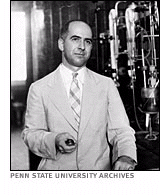Chem 221b
Problem Set 5
Chapter 18
Aldehydes and Ketones
Due: Monday, February 21, 2005
|
" There are more stories told about
Russell Marker than perhaps any other chemist.
Although many of these stories are apocryphal, they are so
fascinating that most of us cannot bear to stop repeating
them. This is the oral history of our profession that we
pass to our colleagues and our students. They are the
campfire stories that bind our profession together."
--Steven M. Weinreb, Russell & Mildred Marker
Professor of Natural Products Chemistry, Pennsylvania State
University
|

Russell Marker (1902-1995)
|
There are some practice exercises in the
aldehyde and ketone modules in ORGO.
|
2. a) Design a synthesis of ketone
1 from benzene, ethylene, and acetone-d6.
[Hexadeuteroacetone is a readily available 1H
NMR solvent.]
b) Draw a mass spectrum for 1. How does it compare
with the mass spectrum in problem 1?
c) How would you prepare (±)-2a from
1?
d) How would you prepare 2b from 1?
|

|
|
3. In each of the following questions,
provide two routes for each chemical transformation. More
than one reation in each route may be required.

|
|
4. Provide structures for A-I.
where mixture are formed, one compound may dominate. For
reactions involving an acid catalyst, provide
mechanisms.

|
|
5. When cyclohexene is subjected to
ozonolysis in methanol/chloroform as a solvent, traces of
HCl are produced and compound A
(C9H20O5) is formed.
Neutralization of the acid with NaHCO3 and
subsequent exposure of A to dimethyl sulfide produces
B
[(CH3O)2CHCH2CH2CH2CH2CHO],
the monodimethyl acetal of adipaldehyde. Provide mechanisms
for the formation of A and B. Why is direct
formation of B from adipaldehyde, methanol, and an
acid catalyst not an efficient procedure?
|
|
6. In the 1930's, progesterone was a rare steroid that held
promise for the reduction of miscarriages. Progesterone was
prepared with great effort from oxidation products of
cholesterol. Marker discovered that the rhizome of the
Mexican yam (cabeza de negro; Dioscorea villosa)
contained dioscin, a saponin (they cause lathering like
soap). Marker extracted the tuber with ethanol and then
treated the concentrated extract with hot aqueous HCl to
remove the sugars D-glucose and L-rhamnose. Diosgenin, the
sapogenin or aglycone (meaning the non-sugar portion of
dioscin) was formed. The ketal of this compound was inert to
aqueous acid, but Marker developed a way to degrade the side
chain and thereby facilitate access to progesterone.
a) How does diosgenin differ from cholesterol?
b) Locate the four acetal (or ketal) functionalities in
diosin.
c) Why is diosgenin unreactive toward aqueous acid yet the
sugars are readily removed from dioscin?
d) Why does the first step in the Marker degradation
differ from aqueous acid hydrolysis?
e) Provide mechanisms for the last three steps in the
degradation: Br2, CrO3, Zn/HOAc. Be
sure to show how and why the double bond moves.
|

|
|
|

|







